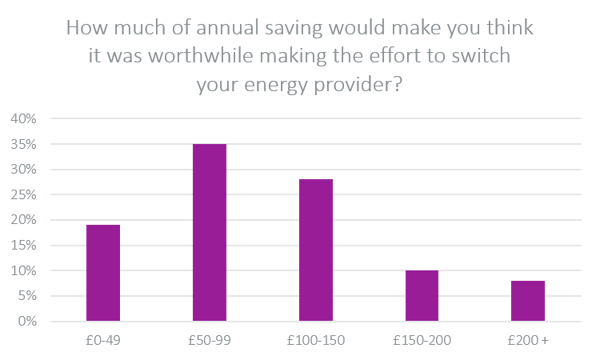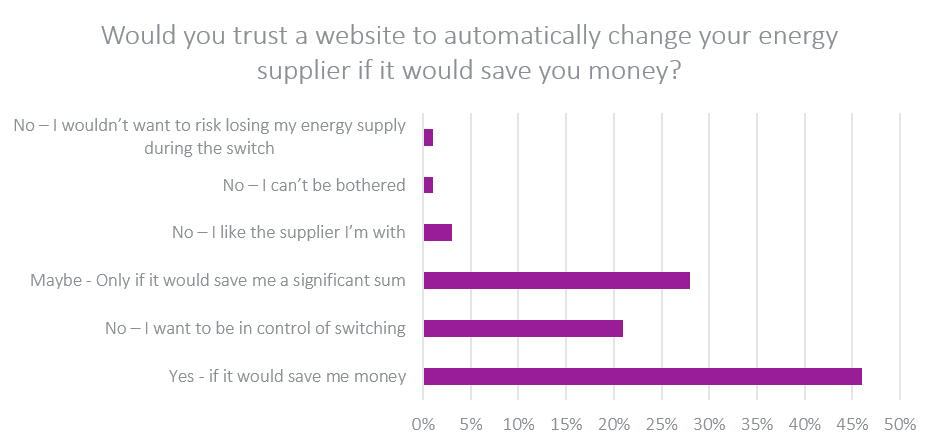
Price comparison websites are offering the next frontier of energy services with their latest offering, autoswitching.
Motorists love falling prices like those we announce today in the latest car insurance price index. But they aren’t such good news for PCWs because consumers are more likely to renew with their existing provider if the price hasn’t gone up by much at renewal instead of shopping around.
PCWs’ business models depend on consumers being motivated enough to make the effort to shop around and switch, and conscious of the benefits and ease of doing so.
Hence, it’s an understandable move for the main PCWs to turn their attention towards other areas where their technology and customer understanding could be applied. Energy has a lot in common with insurance. ‘I love paying my utility bills’ said no one, ever. Ditto insurance.
The similarities continue; ‘standard variable tariffs’ that kick in at the end of a fixed-term energy deal with a new supplier are more expensive, meaning that energy companies can profit from customer inertia. And PCWs can help consumers save money by moving around. Echoes of insurance’s dual pricing problem, anyone?
Instead of expecting consumers to come to them as they do in insurance – and then recommending the best tariff and providers for customers to switch to, some PCWs have developed their energy service further. Some (e.g. WeFlip) now autoswitch. Others (e.g. CompareTheMarket’s Autosergei,MoneySavingExpert’s Energy Club) does the shopping around for you rather than relying on you to come to their site – but then asks for your permission to switch. However, our research confirms 74% of consumers are happy for that switch to be automated.
So what is the consumer appetite for all this? Here are some key findings from a recent poll we conducted with 1,153 consumers from our ViewsBank consumer panel.
1. The tipping point
More than half the people (54%) polled said they would make the effort to switch energy providers for a saving of £99 or less, a lower figure than some in the industry typically work to. This figure rises to 82% for savings of £0-150.
Consumers in areas with a lower cost of living and lower annual wages would switch for a smaller saving. Only 17% of Londoners would switch to save up to £49, compared with 23% of those living in Wales or Yorkshire and The Humber. Men would switch for slightly lower saving that women on average too.

2. The opportunity is big with strong customer demand
Some 35% of consumers polled said they had changed their energy provider in the last year, not many less than the 38% who said they’d changed their car insurance provider in the last year.
This gives PCWs both a committed base of consumers who are already accustomed to shopping around, and a larger amount of people who would benefit from learning about how easy it is to shop around for energy suppliers and what the benefits are.
That 38% of insurance switchers itself is noteworthy for how low it is. Symptomatic of the low rate rises we’ve seen, it reiterates the need for PCWs to broaden into other areas.
3. Plenty of consumers are comfortable with robots
This one surprised us. Only 1% of customers would rule out autoswitching for fear of losing their energy supply. A further 21% said they would rather be in control of switching providers than trust a website to do it for them automatically. For the vast majority of consumers though, the only thing that would put them off is not saving enough money.

4. Autoswitching needn’t be restricted to energy
When the technologies are developed and the principle of auto-switching established, 45% of consumers would be interested in using the service to change their current banking account if it saved them enough money. Some 68% would be interested in auto-switching for their car or home insurance. That’s a big vote of trust in PCWs.
5. It’s all to play for in the branding battle
When we asked consumers to name any energy auto-switching services they’d heard of, unprompted, the biggest name that came up was uSwitch, which was mentioned by 10% of consumers. The curious thing is that uSwitch, whilst energy focused, doesn’t actually have an auto-switching service.
A few mentioned a lizard (remembering WeFlip’s advertising)…but crucially not the brand name.
When prompted, consumers recognised some of the biggest names in autoswitching, but 49% of consumers claimed to have never heard of an autoswitching service.
Expect PR, marketing and advertising campaigns to raise awareness of the category to meerkat level proportions.
Post a comment . . .



Submit a comment